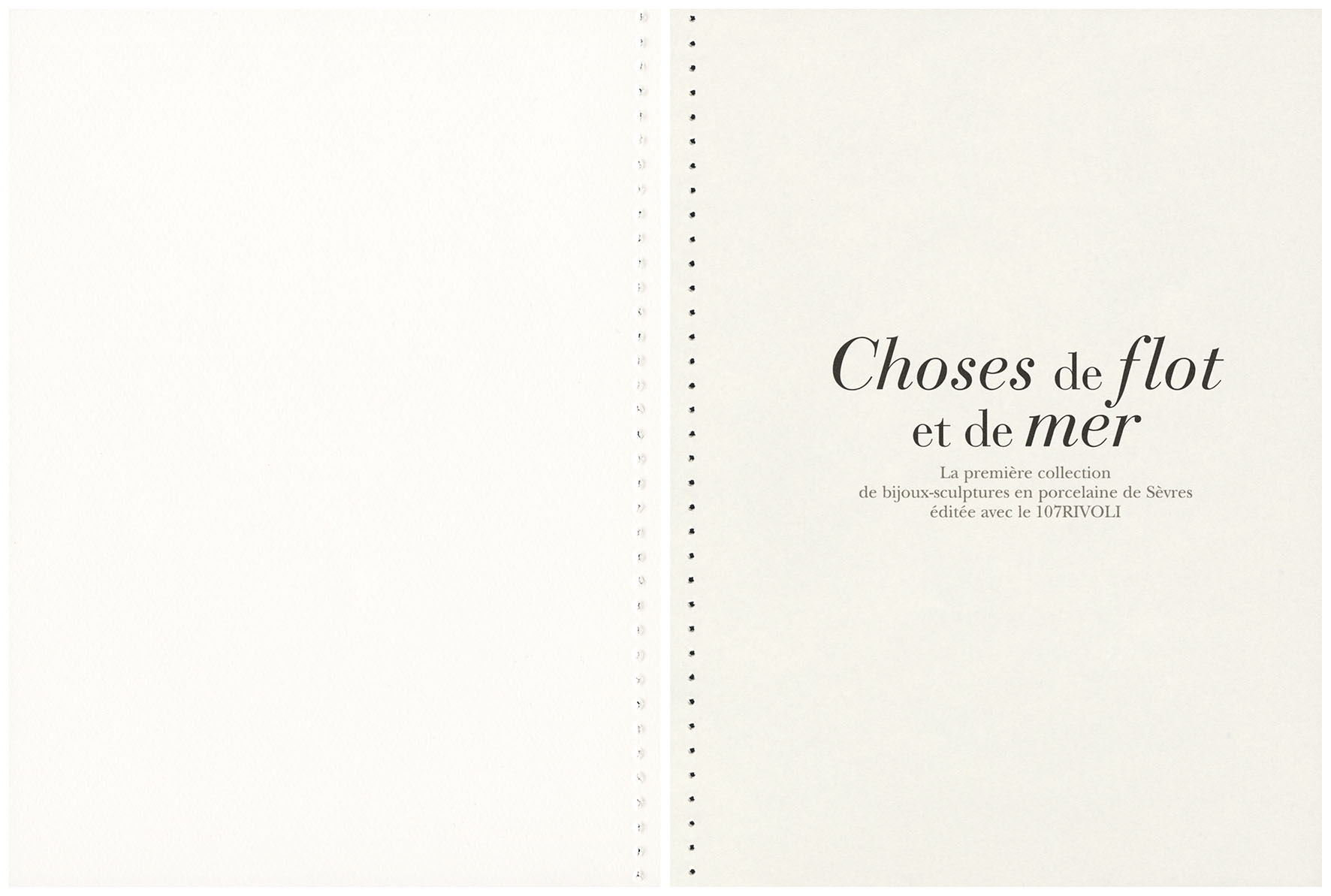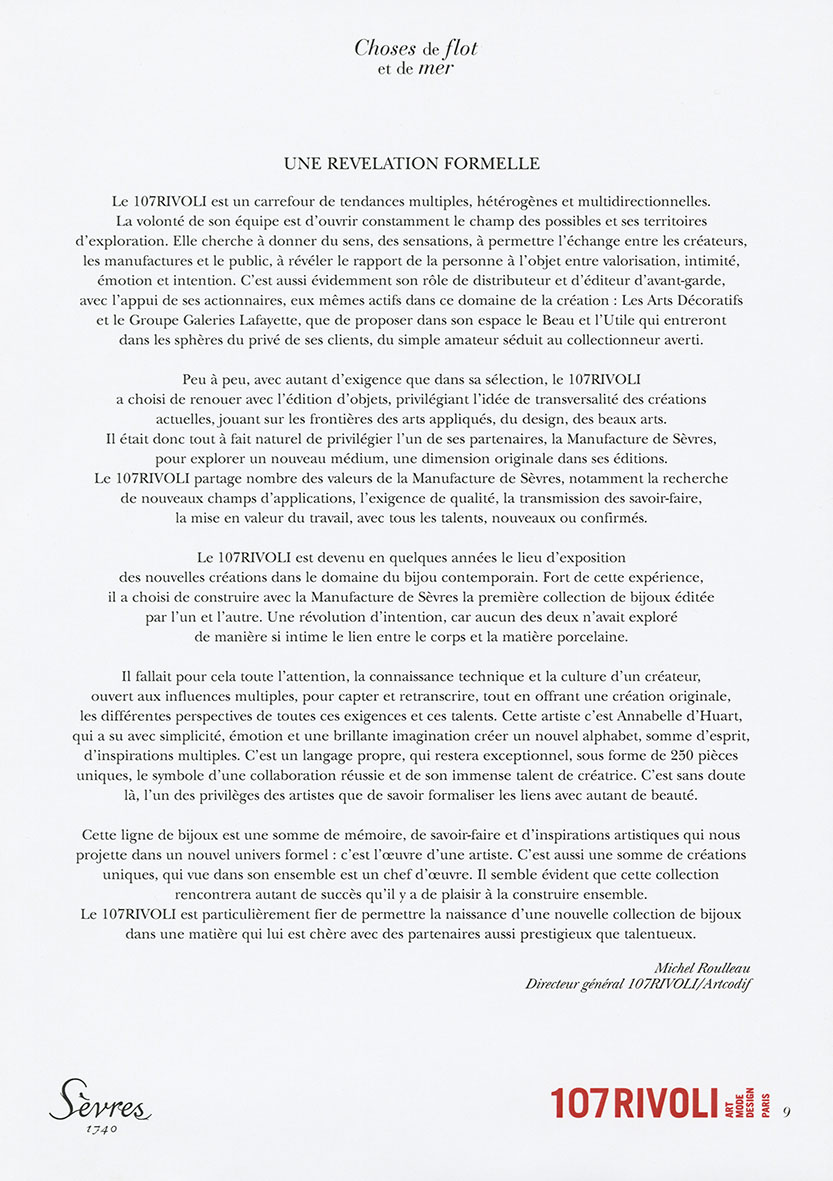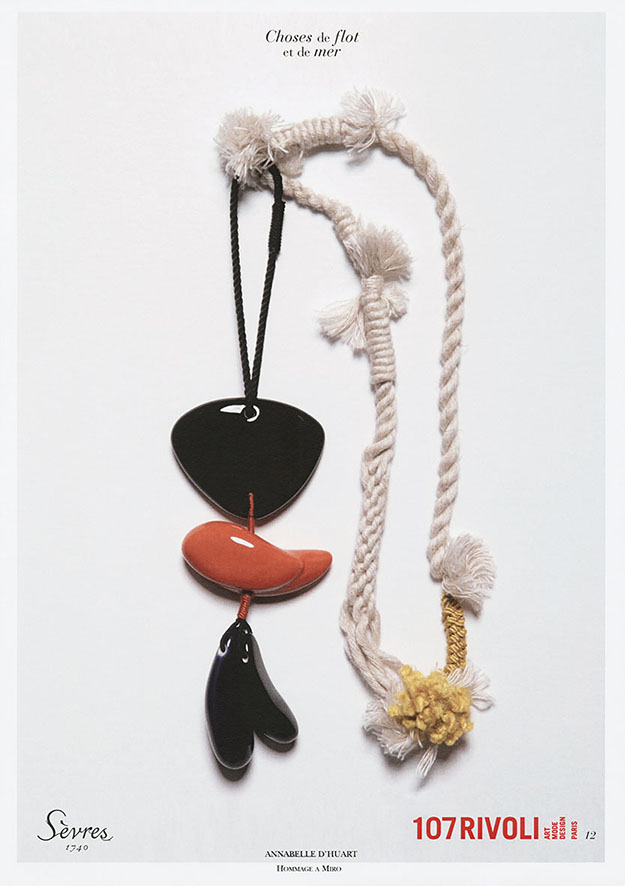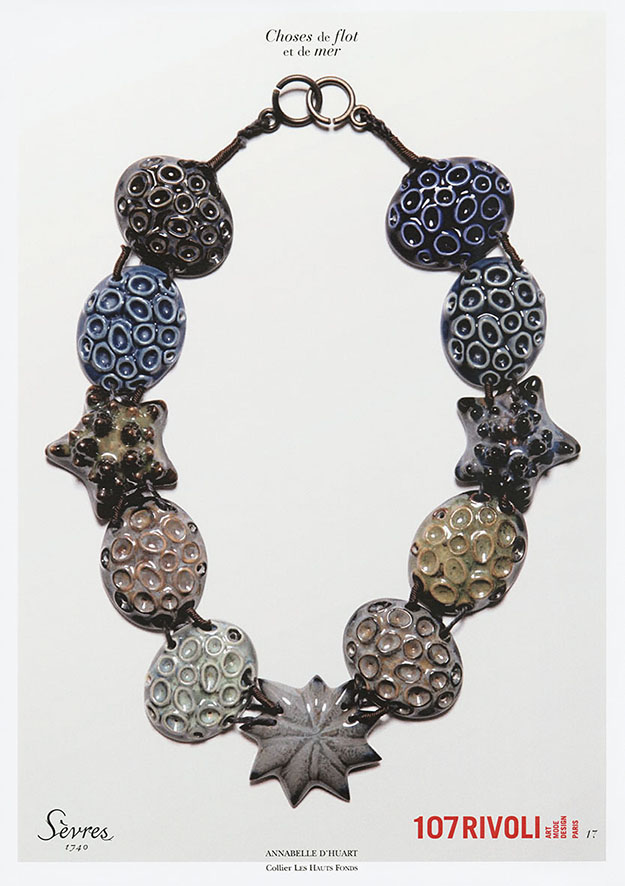2008 – “Choses de flot et de mer”
2008,
Exhibitions
Dates: Monday 15th of September 2008
This exhibition was devoted to the first ever porcelain jewellery collection made by Sèvres with 107Rivoli.
Sèvres – Ceramic City commissioned Annabelle to create their first collection of porcelain jewellery-sculptures titled Choses de flot et de mer. For her third collaboration with Sèvres, she created three hundred unique pieces, fashioned from hard and soft paste porcelain, which seem as though they were sculpted by nature itself. The jewellery is inspired by marine life, the reading of Victor Hugo’s novel Toilers of the Sea (Travailleurs de la Mer), as well as her experience beachcombing in Yemen in 1993. She conceived Choses de flot et de mer as a love letter to the seaside, composed of necklaces, brooches, earrings, pendants and other pocket jewels. Many of these jewels, such as Flotsam No264 or Fairy of the Pearl Cavern, n° 70, are so shiny that they look wet, like colourful pebbles you might see glistening under a the ripple of a wave. One part of Choses de flot et de mer collection was shown at the Museum of Decorative Arts in 2008 and, the remaining pieces were exhibited at Galerie Anne-Sophie Duval in 2010. In 2013, seventy of the three hundred pieces of jewellery became part of the Museum of Ceramics in Sèvres’ collection and are now permanently on display. Following the completion of Choses de flot et de mer, Annabelle created an artists book documenting her ideas and experience which was presented in the Pixi Gallery in 2013.
Location: Museum of Decorative Arts (MAD) and Sèvres Gallery, Paris.
Exhibition: CHOSES DE FLOT ET DE MER
Dates: Monday 15th of September 2008.
Description: This exhibition was devoted to the first ever porcelain jewellery collection made by Sèvres with 107Rivoli.
Sèvres – Ceramic City commissioned Annabelle to create their first collection of porcelain jewellery-sculptures titled Choses de flot et de mer. For her third collaboration with Sèvres, she created three hundred unique pieces, fashioned from hard and soft paste porcelain, which seem as though they were sculpted by nature itself. The jewellery is inspired by marine life, the reading of Victor Hugo’s novel Toilers of the Sea (Travailleurs de la Mer), as well as her experience beachcombing in Yemen in 1993. She conceived Choses de flot et de mer as a love letter to the seaside, composed of necklaces, brooches, earrings, pendants and other pocket jewels. Many of these jewels, such as Flotsam No264 or Fairy of the Pearl Cavern, n° 70, are so shiny that they look wet, like colourful pebbles you might see glistening under a the ripple of a wave. One part of Choses de flot et de mer collection was shown at the Museum of Decorative Arts in 2008 and, the remaining pieces were exhibited at Galerie Anne-Sophie Duval in 2010. In 2013, seventy of the three hundred pieces of jewellery became part of the Museum of Ceramics in Sèvres’ collection and are now permanently on display. Following the completion of Choses de flot et de mer, Annabelle created an artists book documenting her ideas and experience which was presented in the Pixi Gallery in 2013.
Location: Museum of Decorative Arts (MAD) and Sèvres Gallery, Paris.
Catalogue: none.
Press:
LE MONDE, 19 septembre 2008.
LE FIGARO ET VOUS, 16-17 septembre 2008.
LE VIF L’EXPRESS, n° 33, 15-21août 2008.
L’EXPRESS STYLES, n° 2984, 11 septembre 2008.
CONNAISSANCE DES ARTS, septembre 2008.
L’ŒIL, n° 608, décembre 2008.
PARIS CAPITALE, septembre 2008.
CULTURE COMMUNICATION, septembre 2008.
ELLE DECORATION, octobre 2008.
NUMÉRO, n° 97, octobre 2008, “Fée des orfèvres”.
CONNAISSANCE DES ARTS (hors série), n° 4, “Annabelle d’Huart’s necklaces from the sea”, par Elisabeth Vedrenne (below), 2008.
LA LETTRE DE COLBERT, 16 septembre 2008.
ATELIERS D’ART, novembre-décembre 2008.
MÉTIERS D’ART, novembre-décembre 2008.
LA REVUE DE LA CÉRAMIQUE ET DU VERRE, novembre-décembre 2008.
FRANCE TODAY, novembre 2008.
LES ECHOS, “Série limitée, fragile poésie” par S.M.
WEEK-END, 15 août 2008, “Sèvres, à la pointe de la modernité”.
AD, septembre 2008, “Annabelle d’Huart, des bijoux de mer et de porcelaine” par Esther Henwood.
PALACE COSTES, juin 2009.
ANNABELLE D’HUART’S NECKLACES FROM THE SEA
A successful partnership between the talents of Annabelle d’Huart and the Manufacture de Sèvres: a unique encounter between an artist who has finally found herself and an aged lady in the process of reinventing herself. Location: 107Rivoli, Paris.
The Manufacture of Sèvres has had the wisdom to add the discovery of a diverse and unusual group of new artists to the vast and irreplaceable examples of its workmanship, and to stick with them long enough for them to explore their full potential and become brilliantly proficient in porcelain, a medium that can prove difficult to master!
This is how Annabelle d’Huart’s atypical collection of three hundred original small pieces in porcelain came into being, with as many colors as there are types of pebbles, shellfish, corals, starfish or fossils left by the backwash on the sand. Delicately constructed, these mini-sculptures, whose tints the process of firing have made as shimmering as those of the ocean depths, have been structured into fluidly mobile, asymmetrical necklaces.
Annabelle d’Huart has always been considered as having a nimble touch, as well as a wealth of genuine—though elusive—talent. Working daily for a year at the Manufacture de Sèvres, acquiring a familiarity with the complications of the company’s techniques and stages of production, has completely transformed her into an artist with a rigorous approach, a humble sense of patience and a more radical inventiveness. This has entailed a year of research, a year of on-the-job training, a year spent in libraries reading scientific works and literary texts, drawing and photographing. A year spent in accomplishing this enormously ambitious project, co-produced with 107 Rivoli, the decorative arts store. Annabelle d’Huart has attempted to embody the colossal energy of the sea in objects of art, to transform the sea’s work at wearing away into a work of construction and smithing, into the work of a sculptor, to put it briefly. To succeed in expressing this force and this subtlety in miniature form, she had to use fragile, brittle porcelain, which was later to be subjected to a tyrannical furnace, creating the colorings she wanted. And then, at the very end, she had to rearrange these hundreds of small pieces, each different from the other, into the framework of a puzzle for which she alone possessed the key.
Accepting that things will break.
A year to learn patience, the humility to understand the space of time needed to develop a work, but accepting that things might break, as well, knowing how to “recapture the form” at the workshop for “repair,” where you recover what the fire has melted away. One day, in the space of a minute, she lost twelve pieces that had taken four months of preparation. As a consequence, she learned to keep mistakes in mind, to anticipate difficulties and make them a part of the process, to accept the hazards of chance, to organize the chronology of firings, to become satisfied with the slowness of certain rhythms, to become resigned to being dependent, to concentrate for a very long time, but often to make decisions on the spot. Excellently supported by all the players in the Manufacture enterprise, Annabelle d’Huart also realized that each step in this huge collective task was a step toward solidarity. Everything was held together like a great chain, like the links in a necklace… exactly like the depths of that ocean that so fascinated her within its mysterious abysses, where the secret of life was hiding, and the infinitely large could be found in the infinitely small. From this experience was born her desire to interpret the fusion between sea and earth, those two elemental matrixes: the sea, mother of life, and the clay that contains and nourishes it; both matrixes, both “wombs.” The form itself is the foundation, the nucleus of work at Manufacture. Without a mold for casting, there is no porcelain object.
The sea is the great sculptor of the universe. Helped by the wind, the sun, the moon, the rain, its ebb and flow as well as its immobility, it hollows, wrinkles, polishes, drains or eats away, swallows or disposes of everything that exists. In its lap, form and formlessness are constantly engaged in battle. The “mysteriously adjusted deformities,” or that “monstrous grace” mentioned by Victor Hugo, have, among other sources, inspired Annabelle d’Huart, who, in her rereading of Les Travailleurs de la mer (The Toilers of the Sea), created a perfect polish in the tradition of Brancusi just as effectively as she did the bristling velvet of a sea anemone or the lunar, phosphorescent suction pads of an octopus. She has succeeded in rediscovering these sensual textures, these pearly skins, as well as the pitted and crackled coarseness, the stringy oakum of old ropes or the gelatinous sheen of certain kinds of kelp.
Forgotten Colors
The infinite variety of the enamel work at Manufacture has allowed us to recover old colors that have been forgotten by the ceramicists, but d’Huart has also dared, defied and invented, sometimes departing from tradition, or reinterpreting it differently. The result is remarkable. Exceptional. Whether you like her jewelry or not, each small sculpture is an esthetic, as well as a technical, stroke of inspiration. The colorings obtained for this little world of shells, corals, stars, horn, sponges, straps—every blunted and tender form, but also those that are wild and sometimes more aggressive— are a marvel, especially in the light of day, or, as is the case for the pearls, on the skin. The porcelain, which has a reputation for coldness, possesses, in every way, an incredible subtlety. It radiates. It shimmers, changing the luminescence of its tones, going from Matisse blue to Nile green, from the tints of moss to those of the olive, from Chinese celadon to Persian turquoises, from coral to ebony, from garnet to emerald, from dark purples and cassis to eggshell beige and the grays of undergrowth, from gold to silver, from glassy to silky, from lobed to blistered. An endless delight. Annabelle was born under the sign of Pisces, and as a child, she was as hungry for colors as she was for candy… It’s not surprising that she found the secret of these forms, substances and shades that inhabit the waves and the seas. With the ease and grace of the mermaids, she has adorned the skin of the women who remain on dry land.
ELISABETH VEDRENNE




























































